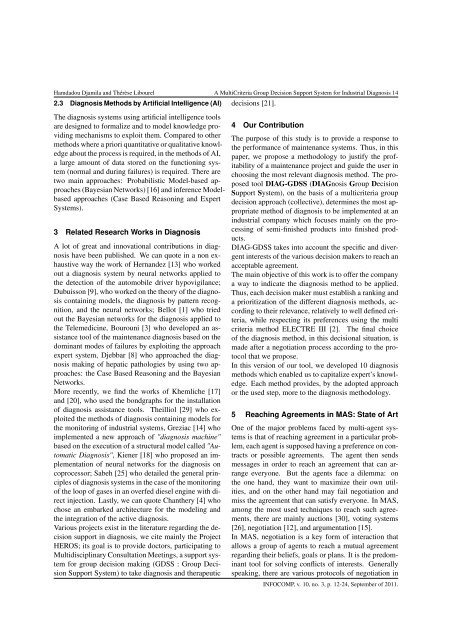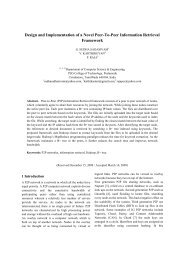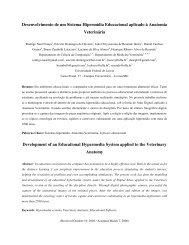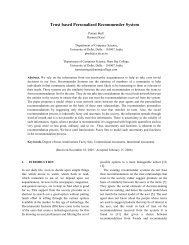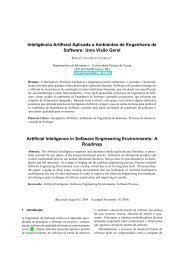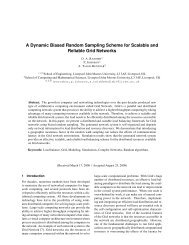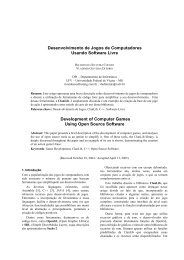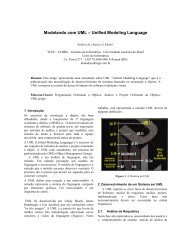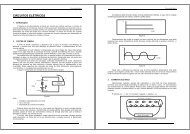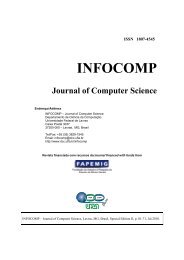INFOCOMP - Departamento de Ciência da Computação - Ufla
INFOCOMP - Departamento de Ciência da Computação - Ufla
INFOCOMP - Departamento de Ciência da Computação - Ufla
Create successful ePaper yourself
Turn your PDF publications into a flip-book with our unique Google optimized e-Paper software.
Ham<strong>da</strong>dou Djamila and Thérèse Libourel A MultiCriteria Group Decision Support System for Industrial Diagnosis 14<br />
2.3 Diagnosis Methods by Artificial Intelligence (AI)<br />
The diagnosis systems using artificial intelligence tools<br />
are <strong>de</strong>signed to formalize and to mo<strong>de</strong>l knowledge providing<br />
mechanisms to exploit them. Compared to other<br />
methods where a priori quantitative or qualitative knowledge<br />
about the process is required, in the methods of AI,<br />
a large amount of <strong>da</strong>ta stored on the functioning system<br />
(normal and during failures) is required. There are<br />
two main approaches: Probabilistic Mo<strong>de</strong>l-based approaches<br />
(Bayesian Networks) [16] and inference Mo<strong>de</strong>lbased<br />
approaches (Case Based Reasoning and Expert<br />
Systems).<br />
3 Related Research Works in Diagnosis<br />
A lot of great and innovational contributions in diagnosis<br />
have been published. We can quote in a non exhaustive<br />
way the work of Hernan<strong>de</strong>z [13] who worked<br />
out a diagnosis system by neural networks applied to<br />
the <strong>de</strong>tection of the automobile driver hypovigilance;<br />
Dubuisson [9], who worked on the theory of the diagnosis<br />
containing mo<strong>de</strong>ls, the diagnosis by pattern recognition,<br />
and the neural networks; Bellot [1] who tried<br />
out the Bayesian networks for the diagnosis applied to<br />
the Telemedicine, Bourouni [3] who <strong>de</strong>veloped an assistance<br />
tool of the maintenance diagnosis based on the<br />
dominant mo<strong>de</strong>s of failures by exploiting the approach<br />
expert system, Djebbar [8] who approached the diagnosis<br />
making of hepatic pathologies by using two approaches:<br />
the Case Based Reasoning and the Bayesian<br />
Networks.<br />
More recently, we find the works of Khemliche [17]<br />
and [20], who used the bondgraphs for the installation<br />
of diagnosis assistance tools. Theilliol [29] who exploited<br />
the methods of diagnosis containing mo<strong>de</strong>ls for<br />
the monitoring of industrial systems, Greziac [14] who<br />
implemented a new approach of "diagnosis machine"<br />
based on the execution of a structural mo<strong>de</strong>l called "Automatic<br />
Diagnosis", Kiener [18] who proposed an implementation<br />
of neural networks for the diagnosis on<br />
coprocessor; Sabeh [25] who <strong>de</strong>tailed the general principles<br />
of diagnosis systems in the case of the monitoring<br />
of the loop of gases in an overfed diesel engine with direct<br />
injection. Lastly, we can quote Chanthery [4] who<br />
chose an embarked architecture for the mo<strong>de</strong>ling and<br />
the integration of the active diagnosis.<br />
Various projects exist in the literature regarding the <strong>de</strong>cision<br />
support in diagnosis, we cite mainly the Project<br />
HEROS; its goal is to provi<strong>de</strong> doctors, participating to<br />
Multidisciplinary Consultation Meetings, a support system<br />
for group <strong>de</strong>cision making (GDSS : Group Decision<br />
Support System) to take diagnosis and therapeutic<br />
<strong>de</strong>cisions [21].<br />
4 Our Contribution<br />
The purpose of this study is to provi<strong>de</strong> a response to<br />
the performance of maintenance systems. Thus, in this<br />
paper, we propose a methodology to justify the profitability<br />
of a maintenance project and gui<strong>de</strong> the user in<br />
choosing the most relevant diagnosis method. The proposed<br />
tool DIAG-GDSS (DIAGnosis Group Decision<br />
Support System), on the basis of a multicriteria group<br />
<strong>de</strong>cision approach (collective), <strong>de</strong>termines the most appropriate<br />
method of diagnosis to be implemented at an<br />
industrial company which focuses mainly on the processing<br />
of semi-finished products into finished products.<br />
DIAG-GDSS takes into account the specific and divergent<br />
interests of the various <strong>de</strong>cision makers to reach an<br />
acceptable agreement.<br />
The main objective of this work is to offer the company<br />
a way to indicate the diagnosis method to be applied.<br />
Thus, each <strong>de</strong>cision maker must establish a ranking and<br />
a prioritization of the different diagnosis methods, according<br />
to their relevance, relatively to well <strong>de</strong>fined criteria,<br />
while respecting its preferences using the multi<br />
criteria method ELECTRE III [2]. The final choice<br />
of the diagnosis method, in this <strong>de</strong>cisional situation, is<br />
ma<strong>de</strong> after a negotiation process according to the protocol<br />
that we propose.<br />
In this version of our tool, we <strong>de</strong>veloped 10 diagnosis<br />
methods which enabled us to capitalize expert’s knowledge.<br />
Each method provi<strong>de</strong>s, by the adopted approach<br />
or the used step, more to the diagnosis methodology.<br />
5 Reaching Agreements in MAS: State of Art<br />
One of the major problems faced by multi-agent systems<br />
is that of reaching agreement in a particular problem,<br />
each agent is supposed having a preference on contracts<br />
or possible agreements. The agent then sends<br />
messages in or<strong>de</strong>r to reach an agreement that can arrange<br />
everyone. But the agents face a dilemma: on<br />
the one hand, they want to maximize their own utilities,<br />
and on the other hand may fail negotiation and<br />
miss the agreement that can satisfy everyone. In MAS,<br />
among the most used techniques to reach such agreements,<br />
there are mainly auctions [30], voting systems<br />
[26], negotiation [12], and argumentation [15].<br />
In MAS, negotiation is a key form of interaction that<br />
allows a group of agents to reach a mutual agreement<br />
regarding their beliefs, goals or plans. It is the predominant<br />
tool for solving conflicts of interests. Generally<br />
speaking, there are various protocols of negotiation in<br />
<strong>INFOCOMP</strong>, v. 10, no. 3, p. 12-24, September of 2011.


